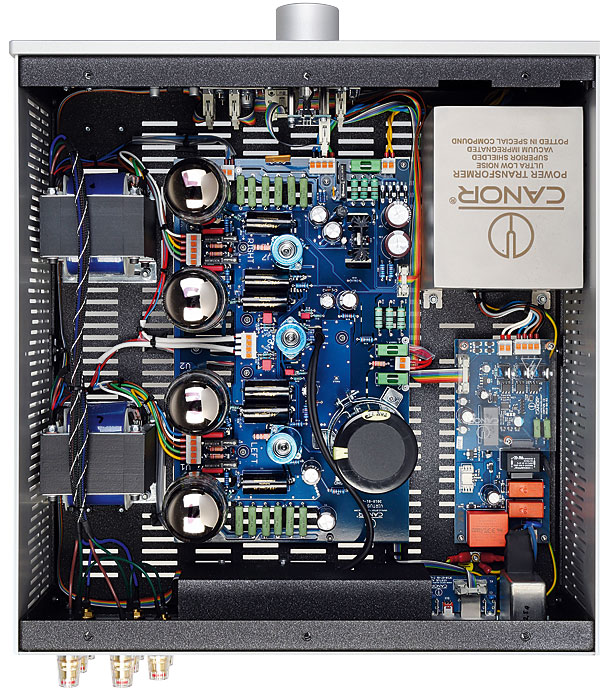Canor Audio Virtus I2 Integrated Amplifier

 This Slovakian design and production facility takes pride in its tube selection, in-house PCB 'milling' and other innovations. Here's the new flagship 'Premium Line' integrated
This Slovakian design and production facility takes pride in its tube selection, in-house PCB 'milling' and other innovations. Here's the new flagship 'Premium Line' integrated
Canor Audio, based in Slovakia, is certainly not the most famous of hi-fi brands, but has been around for longer than many will realise. And, cunningly, it sidesteps the minefield of online rage surrounding tube versus solid-state amplification by manufacturing hybrid amps, a solid-state design, and fully fledged tube products. Canor is clearly smart enough to hedge its bets.
Still, at its heart Canor considers itself 'a tube specialist', albeit a pragmatic one which realises that sometimes other designs can offer more bang for the buck. For example, its forthcoming Virtus A3 all-in-one, designed by hi-fi guru John Westlake, is a tube/transistor hybrid. The Virtus I2 here, however, is an all-analogue integrated amplifier that wholeheartedly embraces tubes while also claiming Class A operation.
Monoblock Potential
Priced at £7500, the Virtus I2 is a new addition to Canor's 'Premium Line', and a step up from the AI 1.10 launched in 2019. Both that older model and the Virtus I2 employ tried-and-tested KT88 tubes, here in switchable ultralinear (UL) and triode modes for a rated 2x40W and 2x20W, respectively. In reality it's a bit less while the choice of mode will come down to both listener preference – triode mode has a reputation for a sweeter and more 'organic' sound – and loudspeaker sensitivity.

Canor also allows pairs of its Virtus I2s to be configured as monoblocks, an option that will both drive the chill from your listening room and sidestep the need for a separate preamp. In this dual-mono set-up one of the two Virtus I2s acts as a master and controls the second unit, making for a more affordable way to upgrade your set-up (if from the off you want to use two monoblocks, Canor sells the £12,000 'Reference Line' Virtus M1).
Making Music
As witnessed when I visited Canor's facilities in the quaint town of Prešov last July, it manufactures nearly everything in-house. It boasts a largescale anodising plant, plus the tooling needed for creating the hefty aluminium housings the company employs, and extensive assembly lines dedicated to OEM work for other manufacturers – something Canor has been doing for decades [HFN Nov '22].
The Virtus I2 puts its manufacturing skill on show. There are artful cut-outs on the top plate, and a brushed fascia that's dissected by a black 'window' running across its full width. This detail is par for the course for Canor, as is the amplifier's excellent build and finish. One advantage of the consistent design language across all its products is that it's easy to mix and match them in a system, even if you complement the Virtus I2 with, for example, a lower-tier ('Performance Line') phono stage or DAC.
Canor's engineering prowess is apparent on the amp's interior too, not only with the tidy production but also with its novel 'Canor Milling Technology' (CMT). Here patterns are cut from the PCB, removing spare areas of substrate that might otherwise contribute added capacitance between adjacent copper tracks. It's rather like point-to-point wiring without, er, the wiring, and is also where Canor's 'air dielectric' claim comes into being.
Tangerine Dream
The company loves the colour orange, saying 'it reminds us of the glow of tubes'. On the Virtus I2, there's the orange glow that's emitted around the large volume dial, this governing a precision stepped attenuator; the orange-lit logo just below; and Canor's familiar orange dot-matrix display. You won't need glasses to read this, as its large type is probably legible even to a passer-by looking in through your window. The display looks neat and shows a fair amount of useful info, but if you find it overwhelming the lighting can be dimmed or turned off entirely.
The Virtus I2's remote feels as luxurious as the amplifier itself, which is refreshing as too often the opulence of high-end kit is let down by a shoddy parts-bin handset. In this case you get a simple but effective device, the only thing missing being a button to switch the unit between triode and UL modes, that facility being left on the amplifier itself.

















































